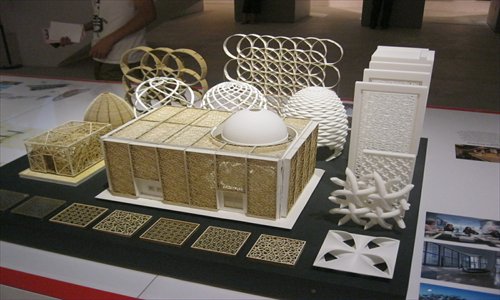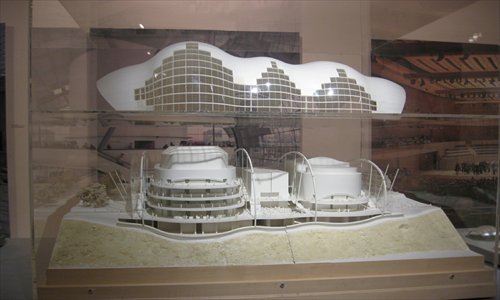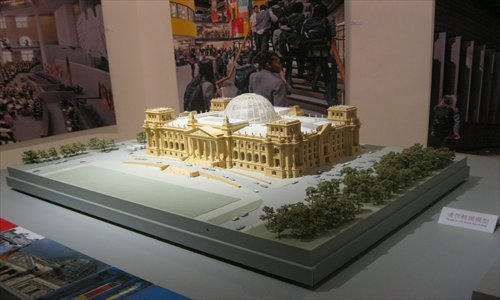Off the drawing board
"I see the essence of architecture as the marriage of art and technology," said Spencer de Grey, senior partner and head of design at Foster + Partners, the UK-based architectural practice founded in 1967.
And currently at the Shanghai Oil Painting and Sculpture Institute, an ongoing exhibition entitled The Art of Architecture is showcasing a number of original models and sketches of high-profile projects completed by the firm over the past 40 years.

In more than 20 countries, the practice has infused its design ethos into a variety of buildings - museums, airports, office towers, opera houses and parliament buildings. The company's highlights include Beijing International Airport, the Millau Viaduct in France, the Hearst Tower in New York and the headquarters of the Swiss Re (a financial service group) in London.
"As the title of the exhibition suggests, it doesn't just apply literally to our work creating galleries and museums, but also to our airports, schools and offices - everything we design aims to lift the spirits in some way," de Grey told the Global Times.

Back to basics
This touring exhibition is curated around various themes including Infrastructure, Sustainability, High-rises, Urban Planning, History, and Culture. And the works on display also showcase the company's growing portfolio of projects in China.
De Grey told the Global Times that their design approach is to go "back to basics, and to question the traditional response and invent or re-invent the solution." "Sustainability is also integral to everything we do and we have an integrated approach to design," he said.
Since joining Foster Associates in 1973, de Grey has become known for a number of architectural works, such as the BBC Radio Center, the Sackler Galleries at the Royal Academy of Arts, the Great Court at the British Museum (all in London), the Boston Museum of Fine Arts and the Winspear Opera House in Dallas.
De Grey is happy that many of the firm's early buildings have endured over time, such as Stansted Airport, which "reinvented the conventional terminal in the 1980s, effectively turning it 'upside down,'" in his words. "We banished all the heavy services usually found at roof level to an undercroft, which allowed the concourse to be flooded with natural light," he added.

Public urban spaces
De Grey and his team also have long explored the scope of public urban spaces. The redesign of Trafalgar Square, part of the World Squares for All master plan for Central London, was a good example of updating a public urban space as a national venue for performances and public events.
This philosophy of restoring civic spaces has continued in such initiatives as the Slussen project in Stockholm and in the West Kowloon Cultural District of Hong Kong. "The latter is a good example of a truly public urban space, because our design was selected by the people of Hong Kong and was a direct response to their hopes for the project," he said.
For the project, de Grey dealt with each important consideration in turn: to reflect Hong Kong's history; to contain facilities for the local arts community; to be able to host an innovative mix of traditional Chinese festivals and contemporary events; to be accessible to all; to be environmentally and economically sustainable; and to have a strong sense of identity.
"We also conducted detailed research to try to establish and replicate the urban DNA of the city. The rich mixture of colonnades, alleyways, lanes and tree-lined promenades are all designed to recall the bustle of Lan Kwai Fong (the famous bar street) and Shanghai Street. In this way, West Kowloon's street pattern will extend into the new quarter so that it becomes a natural extension of the local community - it will be a familiar piece of new city, but without the traffic and pollution. And I think that the new urban park was also a popular feature of the scheme," he added.

Right questions
De Grey said that he believes good design is about listening and asking the right questions - whatever the cultural background. "As we have shown with the sustainable Masdar City master plan (in Abu Dhabi), there are also useful lessons to be learnt from local traditions, planning and from the innovative methods our ancestors devised to plan walkable cities before the car existed, and before the advent of electricity and air conditioning existed in homes," he said.
In China, from the golden sand dune-shaped UAE Pavilion at the World Expo 2010 in Shanghai, to Beijing International Airport, Foster's projects in China are known for their diversity. The company is currently working on a new headquarters for Citic Bank in Hangzhou as well as the Datong Art Museum in Shanxi Province, both of which are under construction. The Nanjing Suning Tower and a new mixed-use district in Shenzhen are currently at the design stage. In Shanghai, meanwhile the Vantone office block development is also underway.
At a free lecture to be held at 6 pm on August 8 at 24/F, 258 Shimen'er Road, Jing'an district, de Grey will discuss the projects and main themes explored in the exhibition. And he plans to share with the Shanghai audience his thoughts on what makes a city sustainable - everything from issues of energy, waste efficiency and infrastructure, to the importance of cultural venues, parks and public spaces.
Date: Until August 25, 10 am to 4 pm (closed on Mondays)
Venue: Shanghai Oil Painting and Sculpture Institute 上海油画雕塑院美术馆
Address: 111 Jinzhu Road
金珠路111号
Admission: Free
Call 6275-9930 for details